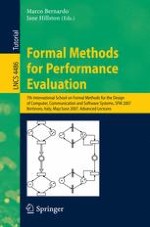2007 | Buch
Formal Methods for Performance Evaluation
7th International School on Formal Methods for the Design of Computer, Communication, and Software Systems, SFM 2007, Bertinoro, Italy, May 28-June 2, 2007, Advanced Lectures
herausgegeben von: Marco Bernardo, Jane Hillston
Verlag: Springer Berlin Heidelberg
Buchreihe : Lecture Notes in Computer Science
